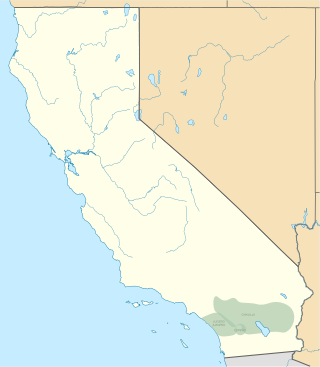
Uto-Aztecan, Uto-Aztekan is a family of indigenous languages of the Americas, consisting of over thirty languages. Uto-Aztecan languages are found almost entirely in the Western United States and Mexico. The name of the language family was created to show that it includes both the Ute language of Utah and the Nahuan languages of Mexico.

Plateau Penutian is a family of languages spoken in northern California, reaching through central-western Oregon to northern Washington and central-northern Idaho.

Serrano is a language in the Serran branch of the Uto-Aztecan family spoken by the Serrano people of Southern California. The language is closely related to Tongva, Tataviam, Kitanemuk and Vanyume. Serrano has free word order with the only rule being that verbs usually come last.
Kitanemuk was a Northern Uto-Aztecan language of the Serran branch. It was very closely related to Serrano, and may have been a dialect. It was spoken in the San Gabriel Mountains and foothill environs of Southern California. The last speakers lived some time in the 1940s, though the last fieldwork was carried out in 1937. J. P. Harrington took copious notes in 1916 and 1917, however, which has allowed for a fairly detailed knowledge of the language.
The Kitanemuk are an indigenous people of California. They traditionally lived in the Tehachapi Mountains and the Antelope Valley area of the western Mojave Desert of southern California, United States. Today some Kitanemuk people are enrolled in the federally recognized Tejon Indian Tribe of California.
Tubar or Tubare, is an extinct language of southern Chihuahua, Mexico that belonged to the Uto-Aztecan language family.

The Tübatulabal are an indigenous people of Kern River Valley in the Sierra Nevada range of California. They may have been the first people to make this area their permanent home. Today many of them are enrolled in the Tule River Indian Tribe. They are descendants of the people of the Uto-Aztecan language group, separating from Shoshone people about 3000 years ago.
The Tataviam language was spoken by the Tataviam people of the upper Santa Clara River basin, Santa Susana Mountains, and Sierra Pelona Mountains in southern California. It had become extinct by 1916 and is known only from a few early records, notably a few words recorded by Alfred L. Kroeber and John P. Harrington in the early decades of the 20th century. These word lists were not from native speakers, but from the children of the last speakers who remembered a few words and phrases.

The Tataviam are a Native American group in Southern California. The ancestral land of the Tataviam people includes northwest present-day Los Angeles County and southern Ventura County, primarily in the upper basin of the Santa Clara River, the Santa Susana Mountains, and the Sierra Pelona Mountains. They are distinct from the Kitanemuk and the Gabrielino-Tongva peoples.
Tepehuán (Tepehuano) is the name of three closely related languages of the Piman branch of the Uto-Aztecan language family, all spoken in northern Mexico. The language is called O'otham by its speakers.
The Kawaiisu language is a Uto-Aztecan language spoken by the Kawaiisu people of California.
Proto-Nahuan is a hypothetical daughter language of the Proto-Uto-Aztecan language. It is the common ancestor from which the modern Nahuan languages have developed.

Aztec–Tanoan is a hypothetical and undemonstrated language family that proposes a genealogical relation between the Tanoan and the Uto-Aztecan families. In some forms, Aztec–Tanoan has also included the Zuni isolate. This proposed classification has not been definitively demonstrated, largely because of slow progress in the reconstruction of the intermediate stages of the two language families involved, but is still considered promising by many linguists. The grouping was originally proposed by Edward Sapir in his 1921 classification, but it was not until 1937 that supporting evidence was published by Benjamin Lee Whorf and G. L. Trager. Their proposal included some 67 proposed cognates, but subsequent reviews have found most of them to be unconvincing. A small number of their proposed cognates do seem to have some merit and in his 1997 review of the hypothesis Lyle Campbell states that the proposal is not implausible but requires detailed study. A recent article by Jane H. Hill argues that the evidence cited for the genetic relation by Whorf and Trager is better understood as a result of language contact between the Uto-Aztecan and Tanoan proto-languages.

The Takic languages are a putative group of Uto-Aztecan languages historically spoken by a number of Indigenous peoples of Southern California. Takic is grouped with the Tubatulabal, Hopi, and Numic languages in the northern branch of the Uto-Aztecan family.
Proto-Uto-Aztecan is the hypothetical common ancestor of the Uto-Aztecan languages. Authorities on the history of the language group have usually placed the Proto-Uto-Aztecan homeland in the border region between the United States and Mexico, namely the upland regions of Arizona and New Mexico and the adjacent areas of the Mexican states of Sonora and Chihuahua, roughly corresponding to the Sonoran Desert and the western part of the Chihuahuan Desert. It would have been spoken by Mesolithic foragers in Aridoamerica, about 5,000 years ago.

The Cupan languages is a branch of the Uto-Aztecan language family that comprises Cupeño, Ivilyuat (Cahuilla), Luiseño-Juaneño, and perhaps Nicoleño, all historically spoken in southern California.
The Tarahumaran languages is a branch of the Uto-Aztecan language family that comprises the Tarahumara and Huarijio languages of Northern Mexico. The branch has been considered to be part of the Taracahitic languages, but this group is no longer considered a valid genetic unit.

The Cahitan languages is a branch of the Uto-Aztecan language family that comprises the Yaqui and the Mayo languages, both of Northern Mexico. The branch has been considered to be part of the Taracahitic languages, but this is no longer considered a valid genetic unit.
The Vanyume or Desert Serrano are an Indigenous people of Southern California. Traditional Vanyume territory extended along the Mojave River from the Eastern Mojave Desert to present day Victorville and may have included portions of southern Antelope Valley. The major village of Wá’peat was part of this area.









